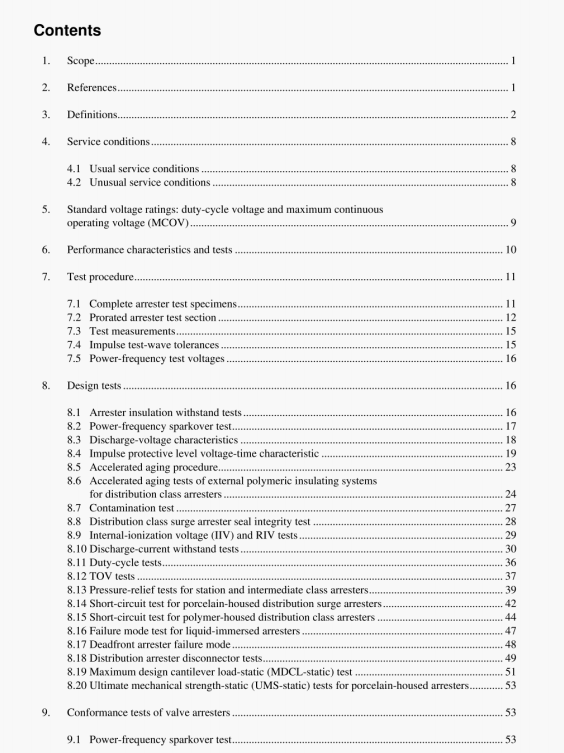IEEE Std C62.11:1999 pdf free download.IEEE Standard for Metal-Oxide Surge Arresters for AC Power Circuits (>1 kV).
3.54 operating duty cycle: One or more Linht operations, as specified.
3.55 oscillatory surge: A surge that includes both positive and negatie polarity values.
3.56 outdoor arrester: An anesier that is designed for outdoor use.
3.57 power-frequency sparko’er voltage: The mis value of the lowest power-frequency sinusoidal voltage that will cause sparkover when applied across the terminals of an arrester.
3.58 power-frequency withstand voltage: A specified rms test voltage at power frequency that will not cause a disruptive discharge.
3.59 production tests: See: routine tests.
3.60 prorated section: A complete. suitably housed part of an arrester, comprising all necessary components, including gaseous medium, in such a proportion as to accurately represent, for a particular test, the characteristics of a complete arrester.
3.61 puncture: (A A disruptive discharge through the body of a solid dielectric. (BA disruptive discharge through solid insulation. C) Term used to denote when a disruptive discharge eccurs through a solid dielectric and produces permanent loss of dielcctnc strength; in a liquid or gaseous dielectric, the loss may be only temporary.
3.62 radio-influence voltage i RIV): A high-frequency voltage, generated by all sources of jonitation current, that appears at the terminals of electric-power apparatus or on power circuits.
3.63 rating: The designation of an operating limit for a device.
3.64 reference current (Iref): The peak value of the resistive component ofa power-frequency current high enough to make the cheers of stray capacitance of the arrester negligible. This current level shall be specified by the manufacturer. Note: Depending on the arrester design. the Iref will typically be in the range of 0.05—I .0 mA per sq cm of’ disk area.
3.65 reference voltage (Vref): The lowest peak value independent of polarity of power-frequency voltage, divided by the square root of 2. required to produce a resistise component of current equal to the reference current of the arrester or arrester element. The reference voltage of a multiunit arrester is the sum ot the reference voltages of the series units. l’he voltage level shall be specified by the manufacturer.
3.66 routine tests: Tests made by the manufacturer on every device or representative samples. or on parts or materials, as required. to verity that the product meets the design specifications.
3.67 series gap: An intentional gap(s) between spaced electrodes in series with the valve elements across which all or part of the impressed arrester terminal voltage appears.
3.68 shunt gap: An intentional gap(s) between spaced electrodes that is electrically in parallel with one or more valve elements.
3.69 sparkover: A disruptive discharge between electrodes of a measuring gap, voltage-control gap. or gap- type protective device.
IEEE Std C62.11:1999 pdf free download
